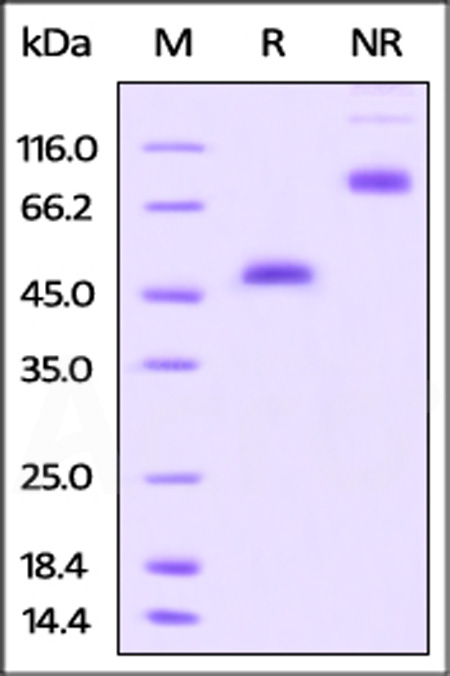分子别名(Synonym)
AITR,GITR,TNFRSF18,CD357
表达区间及表达系统(Source)
Rhesus macaque GITR, Fc Tag (GIR-C5255) is expressed from human 293 cells (HEK293). It contains AA Gln 26 - Glu 161 (Accession # F7DDV8).
Predicted N-terminus: Gln 26
Request for sequence
蛋白结构(Molecular Characterization)

This protein carries a human IgG1 Fc tag at the C-terminus.
The protein has a calculated MW of 41.3 kDa. As a result of glycosylation, the protein migrates as 48 kDa under reducing (R) condition, and 85 kDa under non-reducing (NR) condition (SDS-PAGE).
内毒素(Endotoxin)
Less than 1.0 EU per μg by the LAL method.
纯度(Purity)
>95% as determined by SDS-PAGE.
制剂(Formulation)
Lyophilized from 0.22 μm filtered solution in Tris with Glycine, Arginine and NaCl, pH7.5. Normally trehalose is added as protectant before lyophilization.
Contact us for customized product form or formulation.
重构方法(Reconstitution)
Please see Certificate of Analysis for specific instructions.
For best performance, we strongly recommend you to follow the reconstitution protocol provided in the CoA.
存储(Storage)
For long term storage, the product should be stored at lyophilized state at -20°C or lower.
Please avoid repeated freeze-thaw cycles.
This product is stable after storage at:
- -20°C to -70°C for 12 months in lyophilized state;
- -70°C for 3 months under sterile conditions after reconstitution.
电泳(SDS-PAGE)

Rhesus macaque GITR, Fc Tag on SDS-PAGE under reducing (R) and non-reducing (NR) conditions. The gel was stained with Coomassie Blue. The purity of the protein is greater than 95%.
背景(Background)
Glucocorticoid-induced TNFR-related protein (GITR) is also known as Tumor necrosis factor receptor superfamily member 18 (TNFRSF18), activation-inducible TNFR family receptor (AITR), CD antigen CD357, which is a member of the tumor necrosis factor receptor (TNF-R) superfamily. GITR is receptor for TNFSF18, which seems to be involved in interactions between activated T-lymphocytes and endothelial cells and in the regulation of T-cell receptor-mediated cell death. GITR also mediated NF-kappa-B activation via the TRAF2/NIK pathway.























































 膜杰作
膜杰作 Star Staining
Star Staining












